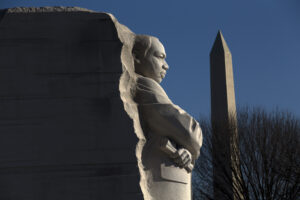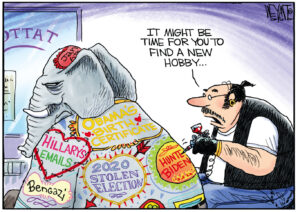A Demographic the Democrats Must Not Forget
Clinton and Obama would court failure by ignoring the white working class, a group that has reasons to be discontented.WASHINGTON — This is a good time to put in a word for the white working class.
For days, the Democratic campaign for president was mired in a discussion, started by Hillary Clinton, about Martin Luther King’s role in winning civil rights laws. There was also much talk of the crucial part women played in the New Hampshire primary.
Clinton and Barack Obama were both so concerned about the racial detour that during the debate in Las Vegas they sounded like penitent schoolchildren apologizing for a playground brawl.
Still, there will be inexorable pressure on both candidates to use identity politics for their own purposes. Gender solidarity was important to Clinton’s campaign-saving victory in New Hampshire, and it could help her again. African-American support will be valuable to Obama, especially in the Democrats’ South Carolina primary on Jan. 26.
But the long term is another matter. To build a majority this fall and make history, either of these candidates will need a lot of help from a group that has its own reasons to be discontented: the white working class.
“Working class” seems an antique term, but it still exists, more now in the service industries than in manufacturing. Demographers often use education levels as a surrogate for class position, and the last three decades have not been kind to Americans who are not college graduates.
For white male high school grads, average wages stood at $18.44 an hour in 1979. They dropped to $16.06 an hour in 1995. There was then a brief upturn — wages for such men hit $17.49 in 2002 — but by 2006, their earnings had fallen to $17.31 an hour. (These numbers are in constant 2006 dollars.)
White female high school graduates have gained ground, but their wages have recently stagnated too. In 1979, such women earned $11.75 an hour. Their wages peaked at $13.42 in 2003, but dropped to $13.08 in 2006. Similar patterns, at somewhat higher wage levels, are visible over the years for men and women who attended college but didn’t graduate.
Family incomes fared a bit better than these numbers would suggest, but for a reason. “To the extent that white working-class incomes went up, it was because women were working more weeks per year and more hours per week,” said Jared Bernstein, a senior economist at the Economic Policy Institute who helped me assemble all of these figures.
The need to boost household incomes through more work by both men and women adds stress on families whose breadwinners enjoy little job flexibility. When Bernstein spoke with me on Thursday, he was working at home, anticipating that he might have to pick his children up from school early because of a snowstorm. It’s not a freedom all workers have. “If I were a cashier at a department store, I probably couldn’t do that,” he said.
Both Clinton and Obama know all this. So does John Edwards, who deserves credit for pushing his competitors to address class issues and whose policies — and “son of a mill worker” speeches — are aimed directly at working-class voters.
A little-noticed part of Clinton’s stump speech demands that more “respect” be given to Americans who will not attend college. “More young people do not go to college than do,” she says. “In fact, it’s close to 60 percent that do not. What are we doing for those 60 percent hardworking, motivated young Americans? I don’t think we’re paying enough attention to them.” She’s got that right.
Obama knows that Clinton has had an edge on him so far among white working-class Democrats, and he has long preached that social reform transcends race and ethnicity. “These days, what ails working-class and middle-class blacks and Latinos is not fundamentally different from what ails their white counterparts,” he wrote in “The Audacity of Hope,” his 2006 book. “And what would help minority workers are the same things that would help white workers.”
But these themes have been garbled, obscured and distorted by the recent distractions. “We’re not going to win on identity politics,” said Rep. Artur Davis, an African-American Democrat from Alabama whose words should be chiseled on the walls of both campaigns’ headquarters. “The Republican Party is sitting there salivating at the prospects of a battle between white females and blacks.”
And the white working class, male and female alike, will wonder what stake it has in the fight. Dr. King, who said that black and white workers were “equally oppressed,” and had “mutual aspirations for a fairer share,” would not have it this way.
E.J. Dionne’s e-mail address is postchat(at)aol.com.
© 2008, Washington Post Writers Group
Your support matters…Independent journalism is under threat and overshadowed by heavily funded mainstream media.
You can help level the playing field. Become a member.
Your tax-deductible contribution keeps us digging beneath the headlines to give you thought-provoking, investigative reporting and analysis that unearths what's really happening- without compromise.
Give today to support our courageous, independent journalists.






You need to be a supporter to comment.
There are currently no responses to this article.
Be the first to respond.